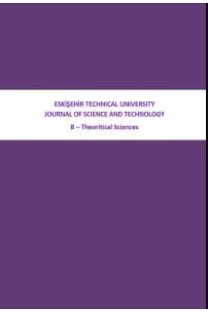TİTANYUM DIOKSİT KATKI MALZEMELERİ POLİKAPROLAKTON NANOKOMPOSİT FİBERLERİNİN SENTEZİ ve KARAKTERİZASYONU
Electrospinning, Nanofiber, Titanyum Dioksit, Polikaprolakton
SYNTHESIS AND CHARACTERIZATION OF POLYCAPROLACTONE NANOCOMPOSITE FIBER WITH TITANIUM DIOXIDE ADDITIVES
Electrospinning, Nanofiber, Polycaprolactone, Titanium Dioxide,
___
- [1] Dural Erdem A, Özcan G. Polymeric Nanocomposites and Their Textile Applications.Tekstil ve Mühendis 2013; 20: 36-47.
- [2] Celep Ş, Koç E. Nanoteknoloji ve Tekstilde Uygulama Alanları.Msc, Çukurova University,Adana, Turkey, 2008.
- [3] Woodruff MA, Hutmacher DW.The return of a forgotten polymer—Polycaprolactone in the 21st century. Progress in Polymer Science 2010; 35:1217–1256.
- [4] Ceylan M, Yang SY, Asmatulu R. Effects of gentamicin-loaded PCL nanofibers on growth of Gram positive and Gram negative bacteria. IJAMBR 2017; 5: 40-51.
- [5] Croisier F, Duwez AS, Jérôme C, Léonard AF, Van der WerfK.O,Dijkstra PJ, Bennink ML.Mechanical testing of electrospun PCL fibers. Acta Biomaterialia 2012; 8; 218-224.
- [6] Bordes C, Fréville V, Ruffin E, Marote P, Gauvrit JY, Briançon S, Lantéri P. Determination of poly(e-caprolactone) solubility parameters: Application to solvent substitution in a microencapsulation process. International Journal of Pharmaceutics 2010; 383:236-243.
- [7] Vert M. Degradable and bioresorbable polymers in surgery and in pharmacology: beliefs and facts. J Mater Sci Mater Med 2009; 20:437-446.
- [8] Theivasanthi T, Alagar M. Titanium dioxide (TiO2) Nanoparticles - XRD Analyses – An Insight. Cornell University Library 2013.
- [9] Macwan DP, Pragnesh ND, Chaturvedi SA. Review on nano-TiO2 sol–gel type syntheses and its applications. J Mater Sci. 2011; 46:3669–3686.
- [10] Gázquez MJ, Bolívar JP, Garcia-Tenorio R,Vaca F. A Review of the Production Cycle of Titanium Dioxide Pigment. Materials Sciences and Applications 2014; 5:441-458.
- [11] Ceylan M. Superhydrophobıc Behavior of Electrospun Nanofibers with Variables Addtives.Wichita State University,Wichita,USA, 2009.
- [12] Ramakrishna S, FujiharaK, Teo WE, Lim TC, Ma Z. Electrospinning Process,” An Introduction to Electrospinning and Nanofibers. 1st Edn,,Singapore: World Scientific Publishing Co. Pte. Ltd, 2005.
- [13] Huang ZM, Zhang YZ, Kotaki M,Ramakrishna SA. Review on polymer nanofibers by electrospinning and their applications in nanocomposites. Composites Science and Technology 2003; 63: 2223-2253.
- [14] Mit-uppatham C, Nithitanakul M, Supaphol P. Ultrafine Electrospun Polyamide-6 Fibers: Effect of Solution Conditions on Morphology and Average Fiber Diameter. Macromolecular Chemistry and Physics 2004; 205: 2327-2338.
- [15] Doshi J, Reneker DH. Electrospinning process and applications of electrospun fibers. Journal of Electrostatics 1995;35:151-160.
- [16] Kim YK, Lewis AF, Patra PK, Warner SB, Mhetre SK, Shah MA, Nam D.Nanocomposite Fibers.College of Engineering University of Massachusetts Dartmouth, 2002.
- [17] Çallıoğlu F. The Production of Nanofiber by Roller Electrospinning Method. Tekstil ve Mühendis 2013;20:35-49.
- [18] Dhakate SR, Singla B, Uppal M, Mathu RB.Effect of processing parameters on morphology and thermal properties of electrospun polycarbonate nanofibers.ADVANCED MATERIALS Letters 2010; 1:200-204.
- [19] Khalifehzadeh F, Shahabi-Ghahfarrokhi I. Investigation of the characteristics of polycaprolactone-TiO2 nanofibers as nano- oxygen scavenger in the food active packaging exposed to UV-C radiation. Journal of Food Research 2019; 29: 65-79.
- [20] Kiran ASK, Kumar TSS, Sanghavi R, Doble M, Ramakrishna S. Antibacterial and Bioactive Surface Modifications of Titanium Implants by PCL/TiO2 Nanocomposite Coatings. Nanomaterials 2018; 8:860.
- ISSN: 2667-419X
- Yayın Aralığı: Yılda 2 Sayı
- Başlangıç: 2010
- Yayıncı: Eskişehir Teknik Üniversitesi
MÜŞTERİ HİZMETLERİ BÖLÜMÜNDE SÜREÇ ANALİZİ VE STRATEJİK PLANLAMA- LASTİK SEKTÖRÜNDE BİR UYGULAMA
İrem UÇAL SARI, Duygu SERGİ, Semih Faruk ÖZUDURUK
Elif Burcu YILMAZ, Muhammet CEYLAN
STABILITY CRITERIA FOR RETARDED FUNCTIONAL DIFFERENTIAL EQUATIONS
Ali Fuat YENİÇERİOĞLU, Cüneyt YAZICI
GENTAMICIN YÜKLENEN PCL NANOFİBERLERİNİN ÇEŞİTLİLİK HÜCRESİNE ETKİSİ VE PLAZMİD DNA ORANI
Muhammet CEYLAN, Shang-you YANG, Ramazan ASMATULU
Özlem GÜRÜNLÜ ALMA, Rabia ÖZAR
AGREGA TANE BOYUTUNUN VE BAĞLAYICI TÜRÜNÜN GEÇİRİMLİ BETON ÖZELİKLERİNE ETKİSİ
Serhat ÇELİKTEN, Mehmet CANBAZ
YIKICI SİSMİK YÜKLER ALTINDA SİLİNDİRİK ÇELİK SU TANKLARININ DOĞRUSAL OLMAYAN ANALİZİ
Ali İhsan ÇELİK, M. Metin KÖSE, Tahir AKGÜL, Ahmet Celal APAY
PATH INTEGRAL SOLUTIONS OF PT-/NON-PT SYMMETRIC AND NON-HERMITIAN DENG-FAN MOLECULAR POTENTIAL
